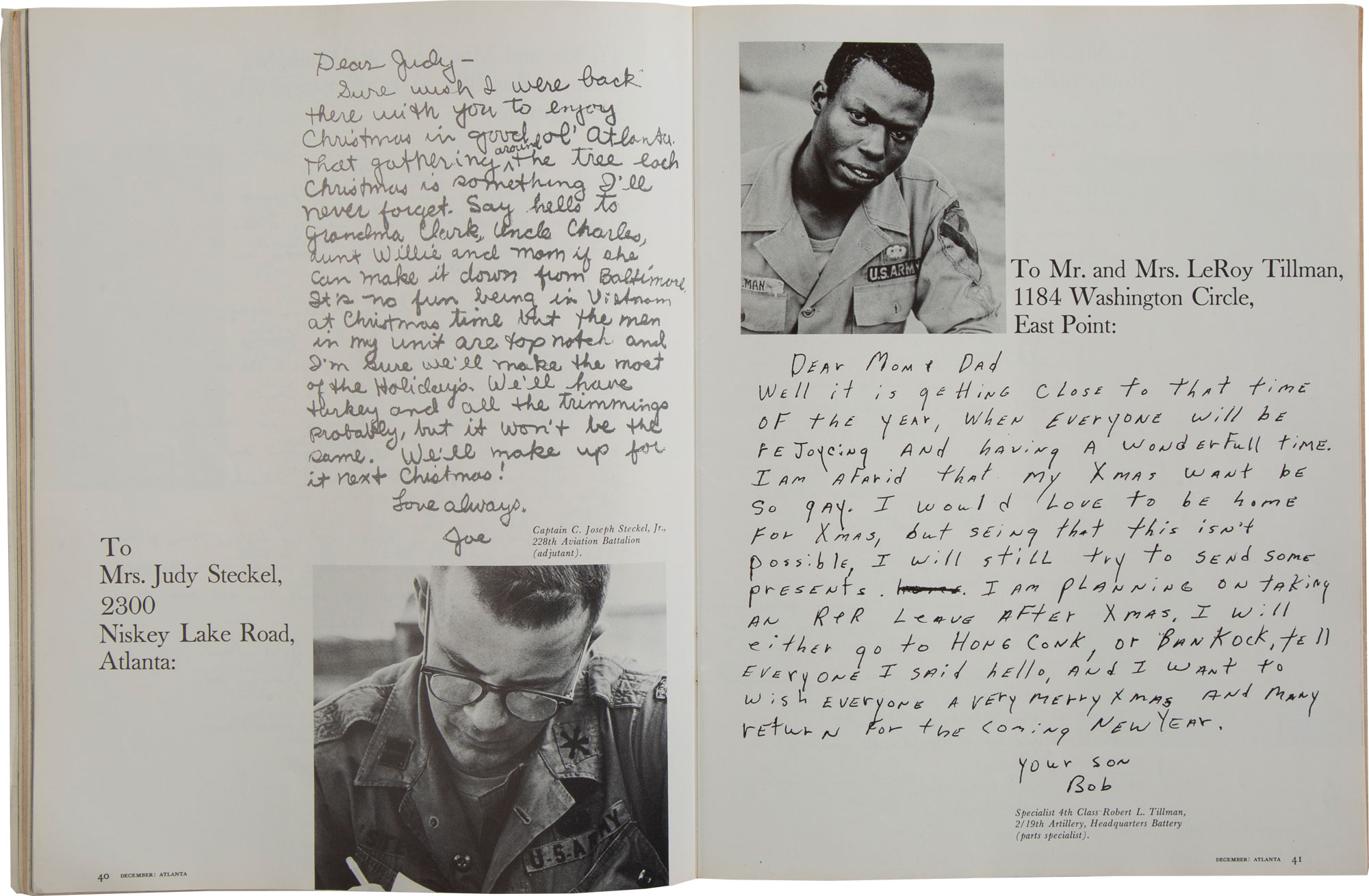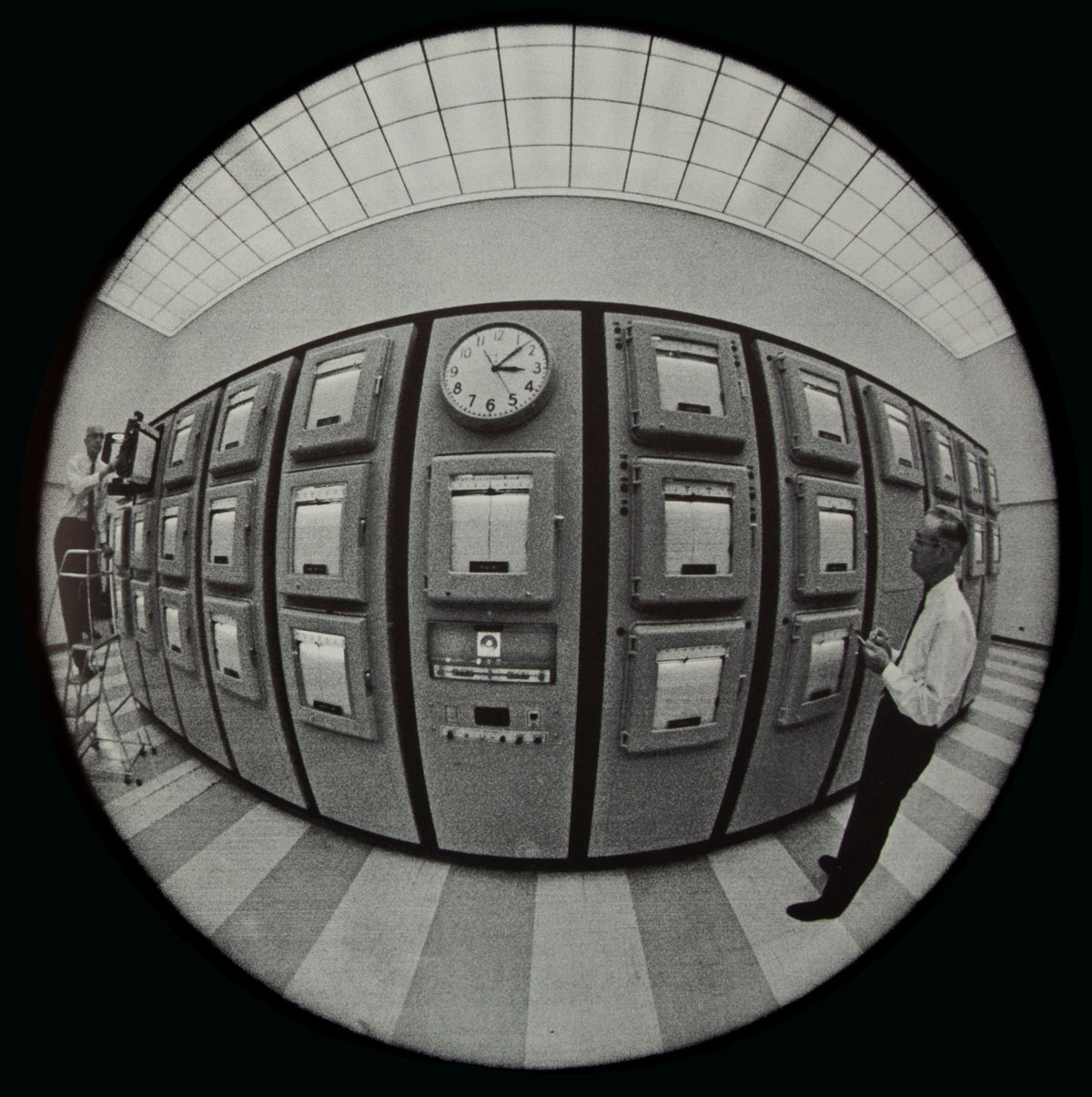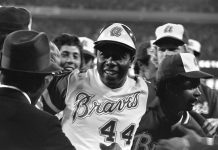
For our January 2021 issue, in honor of our 60th anniversary year, we dug through our archives to present a snapshot of the magazine during each of our six decades. We discovered groundbreaking work, inspiring stories, and, yes, some errors in judgement. Here’s what we found:
The ’60s in 6 Quotes
The era was nothing if not optimistic
“Opening Day at the Mart”
August 1961
“I dunno. I say it’s a big ugly fish. . . . My wife says it’s a gargoyle. But I’ll tell you this . . . I bet they sell it. People have been going in and out of there all day long. This looks more like Chicago than Atlanta.” — Visitor remark upon observing the opening of what is now AmericasMart

Photograph by William F Diehl, Jr.
“Atlanta ’a Go Go”
April 1965
“Fad! This is no fad, friend. They said Presley was a fad, remember? They were giving six months. And the Beatles. Lookit the dance floor. We got four hundred people in here right now, that’s the limit. The line is halfway around the block. And this is Wednesday. We came here second. Straight from Hollywood. Ahead of New York, ahead of Miami.” — owner of the then new Whisk ’a Go Go nightclub
“The Expressway Picture Now”
May 1961
The whole business of expressways is confusing to the layman. . . .
A vast, complex expressway system in a large and famous American city was recently described by Bob Hope as “the fastest parking lot in the west.” Complicated, costly, and staggering in its proportions, this intricate network of concrete fingers—once hailed as the ultimate in traffic planning—now stands on the brink of becoming the largest headache in the country.
“A Major League Boost for the Economy”
August 1964
There’s a cavernous concrete oval rising like an elevator on the edge of town, and Ivan Allen Jr. has staked a piece of his political future on his ability to fill it with major league ballplayers and paying customers. . . . Where minor league baseball has been a sport of the male, major league baseball and major league football become social affairs. It becomes stylish for the ladies to be seen in the stands. This makes a participating party of the former “widow of sports.” What major league sports do for a city is to give that city an entirely fresh image throughout the country.
“The Excitement of Atlanta”
October 1961
This is Atlanta 1961. This is a hunch, a boom, a tingling on the back of the neck, a profit, the goose straining for the golden egg, a direction. This is now. Because, over and through and above it all there runs . . . the excitement of Atlanta. The excitement of Atlanta is a jet, dusty with Spain, skimming red Fulton clay. . . . Sousa in the park, Segovia in the auditorium, and Shakespeare in repertory. . . . smoke and music, and above it all, the people.
“Coca-Cola’s Project Alpha”
May 1963
The task of designing a package for TAB was as challenging as any other facets of this intriguing project. That this drink is both tasty and easy on the diet must be implicit in the design. It must have a shape with high remembrance value [and] an identity all its own. Most importantly, it must have the same dimensions as other packages used by our bottlers and fit all existing machines for bottling and vending. In other words, it must be unique—but the same.
Fixations
Early on, as a Chamber of Commerce publication, this magazine ran many dull reports on topics like textile-industry trends, but we were fixated with two sexier themes.
Planes, trains, & automobiles
The very first news item in our very first issue was “The Lockheed Bid,” about the Marietta company’s successful effort to win the contract to build the C141 jet transport. The team had spent $1.5 million on the effort, shipping one hundred pounds of papers and models in boxes that “strongly resembled coffins.” The second issue featured a painting of the new terminal on the cover and boasted that Atlanta was “the Aviation Center of the South.” Already, the editors noted that “salesmen” often said, “I don’t know whether I’m going to heaven or hell, but I know for sure, whichever it is, I’ll have to change planes in Atlanta.” The same issue contained a photo essay of three mischievous boys inspecting the new terminal. The decade’s pages featured drawings of new airplanes, a five-page story on Lockheed’s StarLifter, maps of flight times (24 hours to Hong Kong! 20 ½ hours to Nairobi!), a CEO profile on the origins of Delta (crop dusting), and features on pilots, private flying (“Businessmen flying their own planes today aren’t the brave, hardy breed who once dared death in the sky. Private flying is as safe as driving a car.”), and, in 1965, “stewardess training” (which opened with a room of 40 “nubile” young women gasping to learn they had to cut their hair, no bouffants allowed).
Nearly as prominent was our fascination with automobiles, which also appeared on the cover. November 1962 included a full-spread illustration of a hot red sports car with white wall tires, “styled especially for Atlanta magazine.” And, though MARTA would not launch until the 1970s, we had begun to speculate about rapid transit.

Illustration by Gene Holtan
Mad Men
Fans of the AMC series Mad Men would have no trouble recognizing characters in the early years of our magazine’s first decade. Many covers were dedicated to “Atlanta’s Madison Avenue,” with bits like “What is an art director?”; “The anatomy of an illustration”; and “Be kind to your printing friends or next year’s campaign may suffer.” The era had an affinity for medieval motifs, reflected in the woodblock illustrations and gothic lettering of the “Businessman’s Guide to Printing.” Our favorite is definitely the 1962 “Child’s Primer to Advertising” (by Alan Barzman with illustrations by Gene Holtan), which contrasted creative and uncreative “ad-men.” To wit: “Creative people are responsible for creating the ads—and uncreative people are responsible for rejecting the ads. Creative people are frustrated because they are not understood. Uncreative people are frustrated because they are not creative people.”
The crisis of affordable housing and the misguided legacy of urban renewal
 January 1962 featured our first cover story on urban renewal. There would be another in 1963. In midcentury America, “urban renewal” was a federal program designed to help cities rehabilitate impoverished areas, enhance urban infrastructure, and provide affordable housing. Though promising in theory, in reality, the movement erased historic neighborhoods, often failed to provide new housing, and displaced thousands of residents, who were disproportionately people of color. Our 1962 story crowed about razing 1,235 acres near the central business district (the areas around Butler Street, Rawson-Washington Streets, and University Center), selling the land to private interests, and adding $125 million to the tax digest.
January 1962 featured our first cover story on urban renewal. There would be another in 1963. In midcentury America, “urban renewal” was a federal program designed to help cities rehabilitate impoverished areas, enhance urban infrastructure, and provide affordable housing. Though promising in theory, in reality, the movement erased historic neighborhoods, often failed to provide new housing, and displaced thousands of residents, who were disproportionately people of color. Our 1962 story crowed about razing 1,235 acres near the central business district (the areas around Butler Street, Rawson-Washington Streets, and University Center), selling the land to private interests, and adding $125 million to the tax digest.
The editors did note, “No longer are slums considered personal problems of people who live in them. Local governments have come to realize an obligation to rehabilitate slum areas for the people who live there.” They confidently added that 1,000 families were moved from “almost inhuman conditions” to private and public housing.
However, by the end of the decade, the magazine had become more realistic about the multifaceted crisis of affordable housing. In 1969, Bruce Galphin, who would later become managing editor, wrote, “Atlanta must house her people—all of them—white and Black, rich and poor. . . . Almost any week there are headlines in Atlanta’s newspapers reporting some new luxury housing development. Not so for the poor. If you’re poor, and especially if you’re Black and single and elderly, housing not only is overpriced; it’s hard to find.”
YMOGs & Powderpuffs
For decades, the magazine featured a department called “Young Men on the Go,” referred to by staff as YMOGs. The columns featured faces still familiar today, such as Sam Massell, James Dickey, and John Portman—nearly all white. Women, apparently, weren’t “on the go.” The first story about professional women appeared in January 1968. (“The Southern woman has stepped off the pedestal and kicked off the crinoline.”) In that era, women were more apt to appear in stories with headlines like August 1962’s cover story, “The Legendary Beauties of Atlanta” or April 1971’s “Powderpuff Power.”
Worst cover idea
 The cover of the November 1965 issue featured a Klansman looking out the eyeholes of his hood, his pupils reflecting a burning cross. The year marked the 50th anniversary of the Invisible Empire of the Knights of the Ku Klux Klan, the organization birthed at Stone Mountain in 1915. Sure, the story mocked the organization, affirmed Atlanta’s intolerance for it, and warned of a recent renaissance. But it also acknowledged that articles in newspapers helped generate publicity and “feed its coffers.” What were we thinking?
The cover of the November 1965 issue featured a Klansman looking out the eyeholes of his hood, his pupils reflecting a burning cross. The year marked the 50th anniversary of the Invisible Empire of the Knights of the Ku Klux Klan, the organization birthed at Stone Mountain in 1915. Sure, the story mocked the organization, affirmed Atlanta’s intolerance for it, and warned of a recent renaissance. But it also acknowledged that articles in newspapers helped generate publicity and “feed its coffers.” What were we thinking?
Prediction
Guess we were channeling George Jetson

Illustration by George Sadler
Driverless Cars
The May 1968 issue predicted that commuters could one day ride driverless electric cars to work. While “he” was at work, the car could drive itself to the garage or be used by other workers.
Trend Setters
Midway through the decade, we started to introduce style pointers
Gift Guide
Our December 1965 gift guide alarmingly included a pair of Civil War replica pistols ($59.50) and a rifle ($295). But in a show of much better judgment, it also featured a sleek Charles Pollock office chair by Knoll ($250) and a Hasselblad camera ($615).
Fashionata
The September 1965 issue featured Rich’s annual Fashionata. We raved that it “bears a great deal more resemblance to a sophisticated, full-production Broadway revue than to the twittering, flower-hatted dovecote of clubwomen belting down finger sandwiches that the term ‘style show’ evokes.” Organizer Sol Kent famously quipped, “We’re selling the sizzle, not the steak.”
The Vietnam War
 In the early ’60s, the magazine was relentlessly optimistic. It seemed to ignore political assassinations and ran no feature on the death of Martin Luther King Jr. (until 1972). But the magazine of that era did invest deeply in covering the Vietnam War.
In the early ’60s, the magazine was relentlessly optimistic. It seemed to ignore political assassinations and ran no feature on the death of Martin Luther King Jr. (until 1972). But the magazine of that era did invest deeply in covering the Vietnam War.
 Twice Atlanta documented soldiers’ lives overseas. In 1966, Vernon Merritt III spent seven months photographing Ronald Griffith, a 28-year-old captain from Rossville, in a remote village south of Saigon. And our December 1966 cover story, “Hello everyone, Well, today is another day in Vietnam,” paired portraits of seven Georgia soldiers, captured by Dick Swanson (Black Star), with their handwritten letters home during the holidays. Jaes Milner Jr., wrote to his parents in Milledgeville: “Most of all, I’m hoping a very merry Christmas to all even though I have to be here fighting to protect our way of living, which I think isn’t the worst thing in the world to face.”
Twice Atlanta documented soldiers’ lives overseas. In 1966, Vernon Merritt III spent seven months photographing Ronald Griffith, a 28-year-old captain from Rossville, in a remote village south of Saigon. And our December 1966 cover story, “Hello everyone, Well, today is another day in Vietnam,” paired portraits of seven Georgia soldiers, captured by Dick Swanson (Black Star), with their handwritten letters home during the holidays. Jaes Milner Jr., wrote to his parents in Milledgeville: “Most of all, I’m hoping a very merry Christmas to all even though I have to be here fighting to protect our way of living, which I think isn’t the worst thing in the world to face.”
What Sort of Mayor? The Odds Favor Ivan
Originally published in January 1962 and excerpted here
 Atlanta’s founding editor, Jim Townsend, was there when Ivan Allen, then president of the Chamber of Commerce, announced his run for mayor. Sort of. He wouldn’t officially enter the race until his predecessor, William B. Hartsfield, confirmed his retirement after 23 years. Mayor Allen would become the only Southern elected official to testify before Congress and endorse the 1964 Civil Rights Act. Technically, the press conference began with Allen’s midyear report on the Chamber’s progress:
Atlanta’s founding editor, Jim Townsend, was there when Ivan Allen, then president of the Chamber of Commerce, announced his run for mayor. Sort of. He wouldn’t officially enter the race until his predecessor, William B. Hartsfield, confirmed his retirement after 23 years. Mayor Allen would become the only Southern elected official to testify before Congress and endorse the 1964 Civil Rights Act. Technically, the press conference began with Allen’s midyear report on the Chamber’s progress:
What he said was interesting. On Schools: “The Atlanta Chamber became one of the first business organizations in the South to recognize that desegregation of schools is a fact of life.” On Expressways: “We adopted an attitude of complete cooperation with public officials rather than one of antagonism.” On Urban Renewal: “The Atlanta Chamber must vigorously support the city’s urban renewal and housing efforts.” On Rapid Transit: “The scope and timing of the project calls for an immediate start at concrete planning and programming.”
Laying the report aside, Ivan stuffed both fists into his coat pockets and leaned tensely forward from the waist in a pose which was to become characteristic of the candidate in coming months: “I will submit my resignation as president of the Atlanta Chamber of Commerce . . . before I make another announcement around the middle of June of a political nature.” That was it; his hat was in the ring.
Systems Go
A fisheye peek behind the power grid

Jay Leviton and Wayne Wilson

Jay Leviton and Wayne Wilson
In this automated age, Atlanta must be a control center, a city of electronic relays, radar screens, computers, radiation shields, valves, cables, switches, and meters. Here are glimpses of the amazing control devices keeping modern Atlanta humming.
—April 1964
This article appears in our January 2021 issue.














